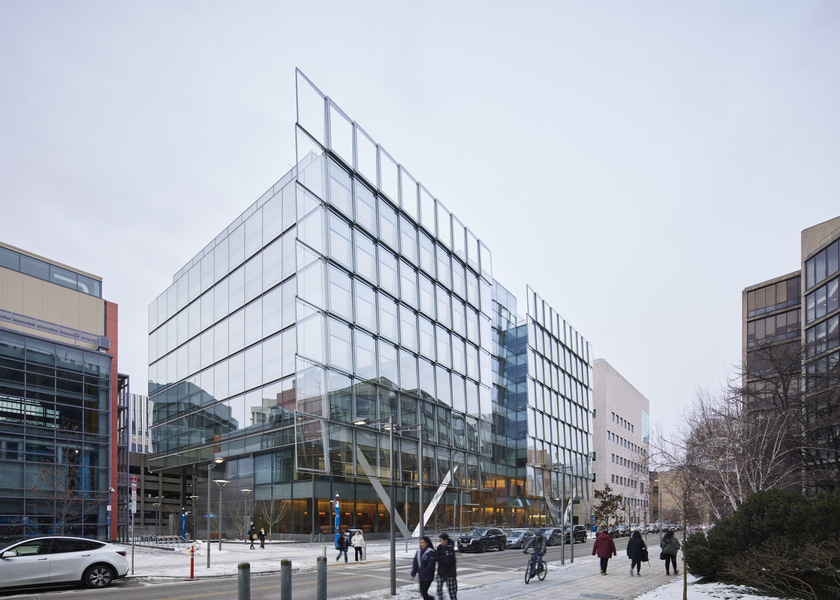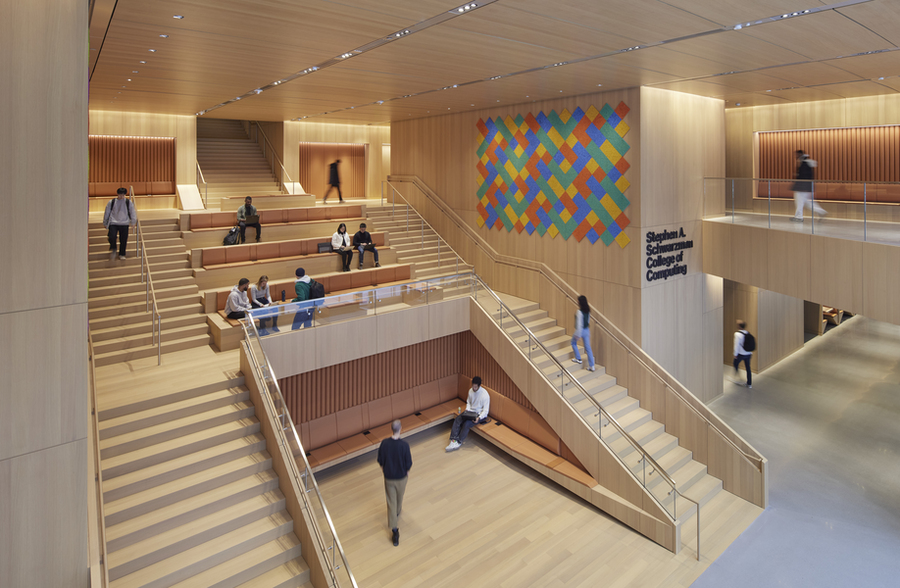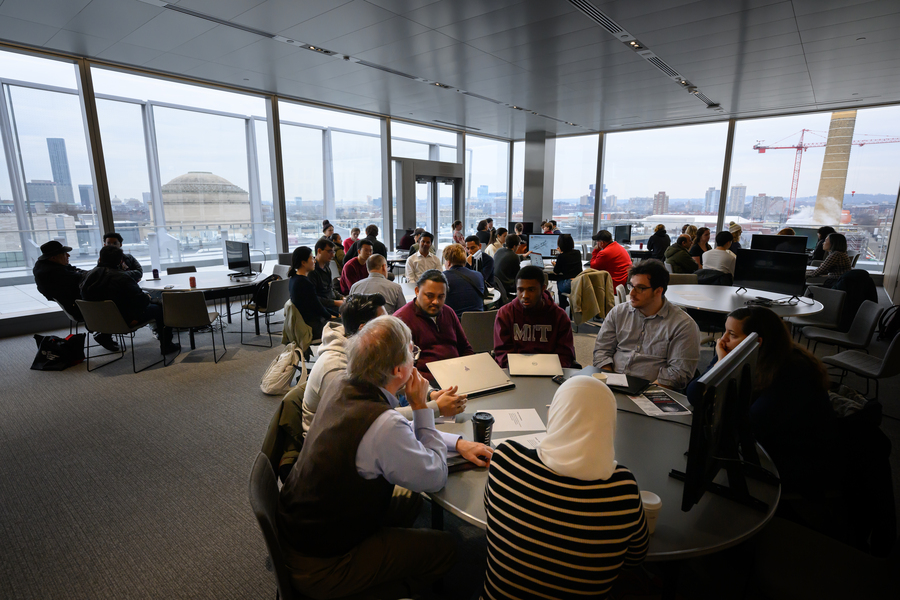A crossroads for computing at MIT
 Situated in the heart of campus on Vassar Street, the central location of the MIT Schwarzman College of Computing building will help form a new cluster of connectivity across a spectrum of disciplines in computing and artificial intelligence at MIT. Photo: Dave Burk/SOM
Situated in the heart of campus on Vassar Street, the central location of the MIT Schwarzman College of Computing building will help form a new cluster of connectivity across a spectrum of disciplines in computing and artificial intelligence at MIT. Photo: Dave Burk/SOM On Vassar Street, in the heart of MIT’s campus, the MIT Stephen A. Schwarzman College of Computing recently opened the doors to its new headquarters in Building 45. The building’s central location and welcoming design will help form a new cluster of connectivity at MIT and enable the space to have a multifaceted role.
“The college has a broad mandate for computing across MIT,” says Daniel Huttenlocher, dean of the MIT Schwarzman College of Computing and the Henry Ellis Warren Professor of Electrical Engineering and Computer Science. “The building is designed to be the computing crossroads of the campus. It’s a place to bring a mix of people together to connect, engage, and catalyze collaborations in computing, and a home to a related set of computing research groups from multiple departments and labs.”
“Computing is the defining technology of our time and it will continue to be, well into the future,” says MIT President Sally Kornbluth. “As the people of MIT make progress in high-impact fields from AI to climate, this fantastic new building will enable collaboration across computing, engineering, biological science, economics, and countless other fields, encouraging the cross-pollination of ideas that inspires us to generate fresh solutions. The college has opened its doors at just the right time.”

A physical embodiment
An approximately 178,000 square foot eight-floor structure, the building is designed to be a physical embodiment of the MIT Schwarzman College of Computing’s three-fold mission: strengthen core computer science and artificial intelligence; infuse the forefront of computing with disciplines across MIT; and advance social, ethical, and policy dimensions of computing.
Oriented for the campus community and the public to come in and engage with the college, the first two floors of the building encompass multiple convening areas, including a 60-seat classroom, a 250-seat lecture hall, and an assortment of spaces for studying and social interactions.
Academic activity has commenced in both the lecture hall and classroom this semester with 13 classes for undergraduate and graduate students. Subjects include 6.C35/6.C85 (Interactive Data Visualization and Society), a class taught by faculty from the departments of Electrical Engineering and Computer Science (EECS) and Urban Studies and Planning. The class was created as part of the Common Ground for Computing Education, a cross-cutting initiative of the college that brings multiple departments together to develop and teach new courses and launch new programs that blend computing with other disciplines.
“The new college building is catering not only to educational and research needs, but also fostering extensive community connections. It has been particularly exciting to see faculty teaching classes in the building and the lobby bustling with students on any given day, engrossed in their studies or just enjoying the space while taking a break,” says Asu Ozdaglar, deputy dean of the MIT Schwarzman College of Computing and head of EECS.
The building will also accommodate 50 computing research groups, which correspond to the number of new faculty the college is hiring — 25 in core computing positions and 25 in shared positions with departments at MIT. These groups bring together a mix of new and existing teams in related research areas spanning floors four through seven of the building.
In mid-January, the initial two dozen research groups moved into the building, including faculty from the departments of EECS; Aeronautics and Astronautics; Brain and Cognitive Sciences; Mechanical Engineering; and Economics who are affiliated with the Computer Science and Artificial Intelligence Laboratory and the Laboratory for Information and Decision Systems. The research groups form a coherent overall cluster in deep learning and generative AI, natural language processing, computer vision, robotics, reinforcement learning, game theoretic methods, and societal impact of AI.
More will follow suit, including some of the 10 faculty who have been hired into shared positions by the college with the departments of Brain and Cognitive Sciences; Chemical Engineering; Comparative Media Studies and Writing; Earth, Atmospheric and Planetary Sciences; Music and Theater Arts; Mechanical Engineering; Nuclear Science and Engineering; Political Science; and the MIT Sloan School of Management.
“I eagerly anticipate the building’s expansion of opportunities, facilitating the development of even deeper connections the college has made so far spanning all five schools,” says Anantha Chandrakasan, chief innovation and strategy officer, dean of the School of Engineering, and the Vannevar Bush Professor of Electrical Engineering and Computer Science.
Other college programs and activities that are being supported in the building include the MIT Quest for Intelligence, Center for Computational Science and Engineering, and MIT-IBM Watson AI Lab. There are also dedicated areas for the dean’s office, as well as for the cross-cutting areas of the college — the Social and Ethical Responsibilities of Computing, Common Ground, and Special Semester Topics in Computing, a new experimental program designed to bring MIT researchers and visitors together in a common space for a semester around areas of interest.
Additional spaces include conference rooms on the third floor that are available for use by any college unit. These rooms are accessible to both residents and nonresidents of the building to host weekly group meetings or other computing-related activities.
For the MIT community at large, the building’s main event space, along with three conference rooms, is available for meetings, events, and conferences. Located eight stories high on the top floor with striking views across Cambridge and Boston and of the Great Dome, the event space is already in demand with bookings through next fall, and has quickly become a popular destination on campus.
The college inaugurated the event space over the January Independent Activities Period, welcoming students, faculty, and visitors to the building for Expanding Horizons in Computing — a weeklong series of bootcamps, workshops, short talks, panels, and roundtable discussions. Organized by various MIT faculty, the 12 sessions in the series delved into exciting areas of computing and AI, with topics ranging from security, intelligence, and deep learning to design, sustainability, and policy.

Form and function
Designed by Skidmore, Owings & Merrill, the state-of-the-art space for education, research, and collaboration took shape over four years of design and construction.
“In the design of a new multifunctional building like this, I view my job as the dean being to make sure that the building fulfills the functional needs of the college mission,” says Huttenlocher. “I think what has been most rewarding for me, now that the building is finished, is to see its form supporting its wide range of intended functions.”
In keeping with MIT’s commitment to environmental sustainability, the building is designed to meet Leadership in Energy and Environmental Design (LEED) Gold certification. The final review with the U.S. Green Building Council is tracking toward a Platinum certification.
The glass shingles on the building’s south-facing side serve a dual purpose in that they allow abundant natural light in and form a double-skin façade constructed of interlocking units that create a deep sealed cavity, which is anticipated to notably lower energy consumption.
Other sustainability features include embodied carbon tracking, on-site stormwater management, fixtures that reduce indoor potable water usage, and a large green roof. The building is also the first to utilize heat from a newly completed utilities plant built on top of Building 42, which converted conventional steam-based distributed systems into more efficient hot-water systems. This conversion significantly enhances the building’s capacity to deliver more efficient medium-temperature hot water across the entire facility.
Grand unveiling
A dedication ceremony for the building is planned for the spring.
The momentous event will mark the official completion and opening of the new building and celebrate the culmination of hard work, commitment, and collaboration in bringing it to fruition.
It will also celebrate the 2018 foundational gift that established the college from Stephen A. Schwarzman, the chair, CEO, and co-founder of Blackstone, the global asset management and financial services firm. In addition, it will acknowledge Sebastian Man ’79, SM ’80, the first donor to support the building after Schwarzman. Man’s gift will be recognized with the naming of a key space in the building that will enrich the academic and research activities of the MIT Schwarzman College of Computing and the Institute.
Media Inquiries
Journalists seeking information about EECS, or interviews with EECS faculty members, should email eecs-communications@mit.edu.
Please note: The EECS Communications Office only handles media inquiries related to MIT’s Department of Electrical Engineering & Computer Science. Please visit other school, department, laboratory, or center websites to locate their dedicated media-relations teams.